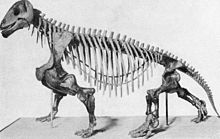| Moschops Temporal range: Capitanian,
| |
|---|---|

| |
| Mounted skeleton | |
| Scientific classification | |
| Domain: | Eukaryota |
| Kingdom: | Animalia |
| Phylum: | Chordata |
| Clade: | Synapsida |
| Clade: | Therapsida |
| Suborder: | †Dinocephalia |
| Family: | †Tapinocephalidae |
| Subtribe: | †Moschopina |
| Genus: | †Moschops Broom, 1911 |
| Type species | |
| †Moschops capensis Broom, 1911
| |
| Species | |
| |
| Synonyms | |
| |
Moschops (Greek for "calf face") is an extinct genus of therapsids that lived in the Guadalupian epoch, around 265–260 million years ago. They were heavily built plant eaters, and they may have lived partly in water, as hippopotamuses do. They had short, thick heads and might have competed by head-butting each other. Their elbow joints allowed them to walk with a more mammal-like gait rather than crawling. Their remains were found in the Karoo region of South Africa, belonging to the Tapinocephalus Assemblage Zone. Therapsids, such as Moschops, are synapsids, the dominant land animals in the Permian period, which ended 252 million years ago.